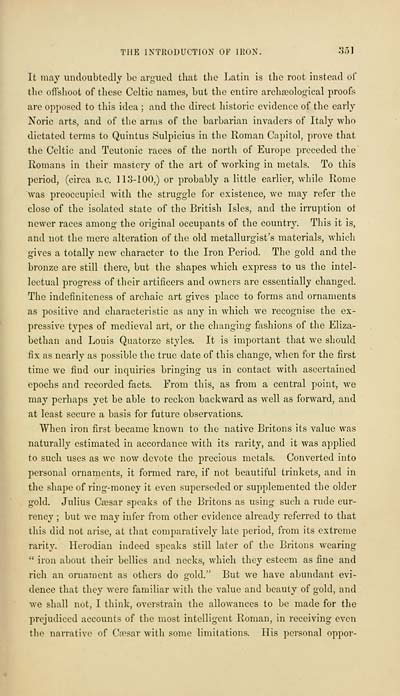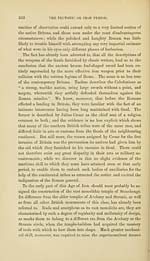Download files
Complete book:
Individual page:
Thumbnail gallery: Grid view | List view

THE INTRODUCTION OF IRON. -^51
It may undoubtedly be argued that tlie Latin is the root instead of
the offshoot of tliese Celtic names, but the entire arcliseological proofs
are opposed to this idea ; and the direct historic evidence of the early
Noric arts, and of the arms of the barbarian invaders of Italy who
dictated terms to Quintus Sulpicius in the Roman Capitol, prove that
the Celtic and Teutonic races of the north of Europe preceded the
Romans in their mastery of the art of working in metals. To this
period, (circa B.C. 113-100,) or probably a little earlier, while Rome
was preoccupied with the struggle for existence, we may refer the
close of the isolated state of the British Isles, and tbe irruption ot
newer races among the original occupants of the country. This it is,
and not the mere alteration of the old metallurgist's materials, which
gives a totally new character to the Iron Period. The gold and the
bronze are still there, but the shapes which express to us the intel-
lectual progress of their artificers and owners are essentially changed.
The indefiniteness of archaic art gives place to forms and ornaments
as positive and characteristic as any in which we recognise the ex-
pressive types of medieval art, or the changing fashions of the Eliza-
bethan and Louis Qiiatorze styles. It is important that we should
fix as nearly as possible the true date of this change, when for the first
time we find our inquiries bringing us in contact with ascertained
epochs and recorded facts. From this, as from a central point, we
may perhaps yet be able to reckon backward as well as forward, and
at least secure a basis for future observations.
When iron first became known to the native Britons its value was
naturally estimated in accordance with its rarit}^, and it was applied
to such uses as we now devote the precious metals. Converted into
personal ornaments, it formed rare, if not beautiful trinkets, and in
the shape of ring-money it even superseded or supplemented the older
gold. Julius Cffisar speaks of the Britons as using such a rude cur-
rency ; but we may infer from other evidence already referred to that
this did not arise, at that comparatively late period, from its extreme
rarity. Herodian indeed speaks still later of the Britons wearing
" iron about their bellies and necks, which they esteem as fine and
rich an ornament as others do gold." But we have abundant evi-
dence that they were familiar with the value and beauty of gold, and
we shall not, I think, overstrain the allowances to be made for the
prejudiced accounts of the most intelligent Roman, in receiving even
the narrative of Caesar with some limitations. His personal oppor-
It may undoubtedly be argued that tlie Latin is the root instead of
the offshoot of tliese Celtic names, but the entire arcliseological proofs
are opposed to this idea ; and the direct historic evidence of the early
Noric arts, and of the arms of the barbarian invaders of Italy who
dictated terms to Quintus Sulpicius in the Roman Capitol, prove that
the Celtic and Teutonic races of the north of Europe preceded the
Romans in their mastery of the art of working in metals. To this
period, (circa B.C. 113-100,) or probably a little earlier, while Rome
was preoccupied with the struggle for existence, we may refer the
close of the isolated state of the British Isles, and tbe irruption ot
newer races among the original occupants of the country. This it is,
and not the mere alteration of the old metallurgist's materials, which
gives a totally new character to the Iron Period. The gold and the
bronze are still there, but the shapes which express to us the intel-
lectual progress of their artificers and owners are essentially changed.
The indefiniteness of archaic art gives place to forms and ornaments
as positive and characteristic as any in which we recognise the ex-
pressive types of medieval art, or the changing fashions of the Eliza-
bethan and Louis Qiiatorze styles. It is important that we should
fix as nearly as possible the true date of this change, when for the first
time we find our inquiries bringing us in contact with ascertained
epochs and recorded facts. From this, as from a central point, we
may perhaps yet be able to reckon backward as well as forward, and
at least secure a basis for future observations.
When iron first became known to the native Britons its value was
naturally estimated in accordance with its rarit}^, and it was applied
to such uses as we now devote the precious metals. Converted into
personal ornaments, it formed rare, if not beautiful trinkets, and in
the shape of ring-money it even superseded or supplemented the older
gold. Julius Cffisar speaks of the Britons as using such a rude cur-
rency ; but we may infer from other evidence already referred to that
this did not arise, at that comparatively late period, from its extreme
rarity. Herodian indeed speaks still later of the Britons wearing
" iron about their bellies and necks, which they esteem as fine and
rich an ornament as others do gold." But we have abundant evi-
dence that they were familiar with the value and beauty of gold, and
we shall not, I think, overstrain the allowances to be made for the
prejudiced accounts of the most intelligent Roman, in receiving even
the narrative of Caesar with some limitations. His personal oppor-
Set display mode to: Large image | Transcription
Images and transcriptions on this page, including medium image downloads, may be used under the Creative Commons Attribution 4.0 International Licence unless otherwise stated. ![]()
| Early Gaelic Book Collections > J. F. Campbell Collection > Archaeology and prehistoric annals of Scotland > (393) |
|---|
| Permanent URL | https://digital.nls.uk/78376010 |
|---|
| Description | Volumes from a collection of 610 books rich in Highland folklore, Ossianic literature and other Celtic subjects. Many of the books annotated by John Francis Campbell of Islay, who assembled the collection. |
|---|
| Description | Selected items from five 'Special and Named Printed Collections'. Includes books in Gaelic and other Celtic languages, works about the Gaels, their languages, literature, culture and history. |
|---|

